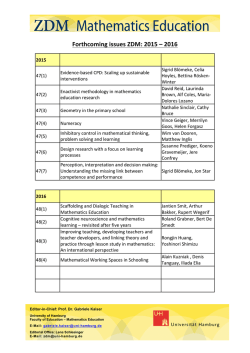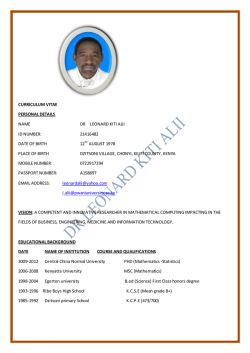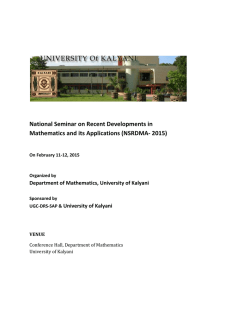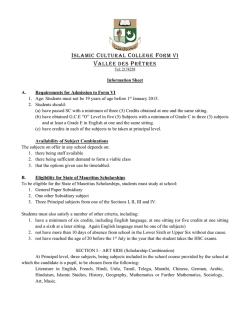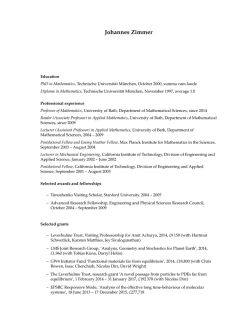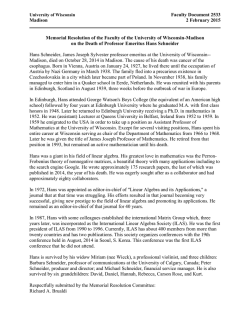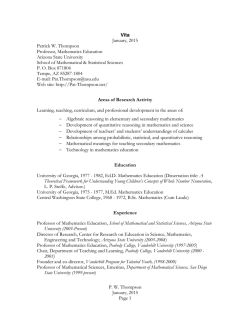
ADDITIONAL MATHEMATICS
MINISTRY OF EDUCATION MALAYSIA IInntteeggrraatteedd C m ffoorr SSeeccoonnddaarryy SScchhoooollss Cuurrrriiccuulluum S SY YLLLLA AB BU US S ADDITIONAL MATHEMATICS Curriculum Development Centre Ministry of Education Malaysia 2006 PREFACE Science and technology plays a critical role in realising Malaysia’s aspiration to become a developed nation. Since mathematics is instrumental in the development of scientific and technological knowledge, the provision of quality mathematics education from an early age in the education process is thus important. The Malaysian school curriculum offers three mathematics education programs, namely Mathematics for primary schools, Mathematics and Additional Mathematics for secondary schools. The Malaysian school mathematics curriculum aims to develop mathematical knowledge, competency and inculcate positive attitudes towards mathematics among pupils. While the Mathematics curriculum prepares pupils to cope with daily life challenges, the Additional Mathematics curriculum provides an exposure to the level of mathematics appropriate for science and technology related careers. As with other subjects in the secondary school curriculum, Additional Mathematics aims to inculcate noble values and love for the nation in the development of a holistic person, who in turn will be able to contribute to the harmony and prosperity of the nation and its people. Additional Mathematics is an elective subject offered to the upper secondary school pupils. Beginning 2003, English is used as the medium of instruction for Science and Mathematics subjects. The policy to change the medium of instruction for the two subjects follows a phased implementation schedule and is expected to be completed by 2008. The teaching and learning of Additional Mathematics in English started in 2006. The use of technology in the teaching and learning of Additional Mathematics is greatly emphasised. Additional Mathematics taught in English, coupled with the use of ICT, provide greater opportunities for pupils to improve their knowledge and skills in mathematics because of the richness of resources and repositories of knowledge in English. Our pupils will be able to interact with pupils from other countries, improve their proficiency in English; and thus make the learning of mathematics more interesting and exciting. The development of this Additional Mathematics syllabus is the work of many individuals and experts in the field. On behalf of the Curriculum Development Centre, I would like to express much gratitude and appreciation to those who have contributed in one way or another towards this initiative. (MAHZAN BIN BAKAR SMP, AMP) Director Curriculum Development Centre Ministry of Education Malaysia RUKUNEGARA DECLARATION OUR NATION, MALAYSIA, being dedicated • • • to achieving a greater unity of all her peoples; • to ensuring a liberal approach to her rich and diverse cultural traditions; • to building a progressive society which shall be oriented to modern science and technology; to maintaining a democratic way of life; to creating a just society in which the wealth of the nation shall be equitably shared; WE, her peoples, pledge our united efforts to attain these ends guided by these principles: • • • • • BELIEF IN GOD LOYALTY TO KING AND COUNTRY UPHOLDING THE CONSTITUTION RULE OF LAW GOOD BEHAVIOUR AND MORALITY Education in Malaysia is an ongoing effort towards further developing the potential of individuals in a holistic and integrated manner so as to produce individuals who are intellectually, spiritually, emotionally and physically balanced and harmonious, based on a firm belief in God. Such an effort is designed to produce Malaysian citizens who are knowledgeable and competent, who possess high moral standards, and who are responsible and capable of achieving a high level of personal well-being as well as being able to contribute to the betterment of the family, the society and the nation at large. INTRODUCTION A well-informed and knowledgeable society, well versed in the use of Mathematics to cope with daily life challenges is integral to realising the nation’s aspiration to become an industrialised nation. Thus, efforts are taken to ensure a society that assimilates mathematics into their daily lives. Pupils are nurtured from an early age with the skills to solve problems and communicate mathematically, to enable them to make effective decisions. Mathematics is essential in preparing a workforce capable of meeting the demands of a progressive nation. As such, this field assumes its role as the driving force behind various developments in science and technology. In line with the nation’s objective to create a knowledge-based economy, the skills of Research & Development in mathematics is nurtured and developed at school level. Additional Mathematics is an elective subject in secondary schools, which caters to the needs of pupils who are inclined towards Science and Technology. Thus, the content of the curriculum has been organised to achieve this objective. The design of the Additional Mathematics syllabus takes into account the contents of the Mathematics curriculum. New areas of mathematics introduced in the Additional Mathematics curriculum are in keeping with new developments in Mathematics. Emphasis is placed on the heuristics of problem solving in the process of teaching and learning to enable pupils to gain the ability and confidence to use mathematics in new and different situations. The Additional Mathematics syllabus emphasises understanding of concepts and mastery of related skills with problem solving as the main focus in the teaching and learning process. Skills of communication through mathematics are also stressed in the process of learning Additional Mathematics. When pupils explain concepts and their work, they are guided in the use of correct and precise mathematical terms and sentences. Emphasis on Mathematical communications develops pupils’ ability in interpreting matters into mathematical modellings or vice versa. The use of technology especially, Information and Communication Technology (ICT) is much encouraged in the teaching and learning process. Pupils’ understanding of concepts can be enhanced as visual stimuli are provided and complex calculations are made easier with the use of calculators. Project work, compalsory in Additional Mathematics provides opportunities for pupils to apply the knowledge and skills learned in the classroom into real-life situations. Project work carried out by pupils includes exploration of mathematical problems, which activates their minds, makes the learning of mathematics more meaningful, and enables pupils to apply mathematical concepts and skills, and further develops their communication skills. The intrinsic values of mathematics namely thinking systematically, accurately, thoroughly, diligently and with confidence, infused throughout the teaching and learning process; contribute to the moulding of character and the inculcation of positive attitudes towards mathematics. Together with these, moral values are also introduced in context throughout the teaching and learning of mathematics. Assessment, in the form of tests and examinations helps to gauge pupils’ achievement. Assessments in Additional Mathematics include aspects such as understanding of concepts, mastery of skills and non-routine questions that demand the application of problem-solving strategies. The use of good assessment data from a variety of sources provides valuable information on the development and progress of pupils. On-going assessment built into the daily lessons allows the identification of pupils’ strengths and weaknesses, and effectiveness of the instructional activities. Information gained from responses to questions, group work results, and homework helps in improving the teaching process, and hence enables the provision of effectively aimed lessons. 6 use the knowledge and skills of Mathematics to interpret and solve real-life problems, 7 debate solutions using precise mathematical language, 8 relate mathematical ideas to the needs and activities of human beings, 9 use hardware and software to explore mathematics, and 10 practise intrinsic mathematical values. AIM The Additional Mathematics curriculum for secondary schools aims to develop pupils with in-depth mathematical knowledge and ability, so that they are able to use mathematics responsibly and effectively in communications and problem solving, and are prepared to pursue further studies and embark on science and technology related careers. OBJECTIVES CURRICULUM ORGANISATION The contents of the Additional Mathematics curriculum are organised into two learning packages. They are the Core Package and the Elective Package. The Additional Mathematics curriculum enables pupils to: 1 widen their ability in the fields of number, shape and relationship as well as to gain knowledge in calculus, vector and linear programming, 2 enhance problem-solving skills, 3 develop the ability to think critically, creatively and to reason out logically, make inference and reasonable generalisation from given information, 4 5 relate the learning of Mathematics to daily activities and careers, The Core Package, which is compulsory for all pupils comprises of five components namely: • Geometry • Algebra • Calculus • Trigonometry • Statistics The Elective Package consists of two application packages: • • Science and Technology Application Social Science Application Pupils need to choose only one application package from the Elective Package based on their inclination and field of interest. Pupils inclined towards science and technology are encouraged to choose the Science and Technology Application Package, while those inclined towards commerce, literature and economy are encouraged to choose the Social Science Application Package. G2. Vectors 1. Introduction to vectors and their properties. 2. Addition and subtraction of vectors. 3. Expressing a vector as a combination of other linear vectors. 4. Vectors in the Cartesian plane. Algebra In the Core Package, each component consists of topics related to a branch in mathematics. Topics in each component are organised hierarchically with the easier topics to be learned first before going on to the more complex ones. CONTENT A1. Functions 1. Relations. 2. Functions. 3. Composite functions. 4. Inverse functions. A2. Quadratic Equations 1. Quadratic equations and their roots. 2. Solving quadratic equations. 3. Conditions for quadratic equations to have • Two different roots • Two equal roots • No roots. A3. Quadratic Functions 1. Quadratic functions and their graphs. 2. Maximum and minimum values of quadratic functions. 3. Sketching graphs of quadratic functions. 4. Quadratic inequalities. A4. Simultaneous Equations 1. Simultaneous equations in two unknown: one linear equation and one non-linear equation. This section lists the topics in each learning package. CORE PACKAGE This package consists of five learning components. Geometry G1. Coordinate Geometry 1. Distance between two points. 2. Division of line segments. 3. Area of polygons. 4. Equation of straight lines. 5. Parallel and perpendicular lines. 6. Equation of locus involving distance between two points. A5. A6. A7. Indices and Logarithms 1. Indices and laws of indices. 2. Logarithms and laws of logarithms. 3. Changing the base of logarithms. 4. Equations involving indices and logarithms. Progressions 1. Arithmetic progressions. 2. Geometric progressions. Trigonometry T1. Circular Measures 1. Radians. 2. Length of an arc of a circle. 3. Areas of sectors. T2. Trigonometric Functions 1. Positive and negative angles in degrees and radians. 2. Six trigonometric functions of any angle. 3. Graphs of sine, cosine and tangent functions. 4. Basic Identities: sin2A + cos2A = 1, sec2A = 1 + tan2A, cosec2A = 1 + cot2A 5. Addition formulae and double angle formulae: sin(A ± B), cos(A ± B), tan(A ± B), sin 2A, cos 2A, tan 2A Linear Law 1. Line of best fit. 2. Application to non-linear functions. Calculus C1. C2. Differentiation 1. Gradients of curves and differentiation. 2. Differentiation of axn; (n is an integer), differentiation of the sum of algebraic functions; tangents and normals to curves. 3. Differentiation of the products and quotients of algebraic functions; differentiation of composite functions. 4. Application to minimum and maximum values, rates of change, small changes and approximations. 5. Second derivative. Integration 1. Integration as an inverse of differentiation. 2. Integration of axn (n is an integer, n ≠ –1). 3. Integration by substitution. 4. Definite integrals. 5. Integration as a sum, area and volume. Statistics S1. Statistics 1. Measures of central tendency: mean, mode and median. 2. Measures of dispersion: range, interquartile range, variance and standard deviation. S2. Permutations and Combinations 1. Permutations. 2. Combinations. S3. Probability 1. Probability of an event. 2. Probability of mutually exclusive events. 3. Probability of independent events. S4. Probability Distributions 1. Discrete probability distribution and binomial distribution. 2. Continuous probability distribution and normal distribution. ELECTIVE PACKAGE The Elective Package consists of two application packages. Pupils are to choose only one application package. Science and Technology Application Package AST1. Solutions of Triangles 1. Sine rule. 2. Cosine rule. 3. Areas of triangles. AST2. Motion Along a Straight Line 1. Displacement. 2. Velocity. 3. Acceleration. Social Science Application Package ASS1. Index Number 1. Index number. 2. Composite index. ASS2. Linear Programming 1. Graphs of linear inequalities. 2. Solving linear programming problems.
© Copyright 2025
